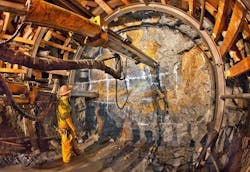California Water Transmission Tunnel Excavation Complete
After two and a half years of digging hundreds of feet underground, two crews of miners finally reached their goal—meeting up. San Francisco Public Utilities Commission’s (SFPUC) New Irvington Tunnel Project achieved what tunnelers call final hole-through today. A road header from one heading punched through hard rock underground to find air—and their fellow miners—on the other side.
“This project is a key part of our $4.6 billion Water System Improvement Program,” said SFPUC General Manager Harlan Kelly Jr. “I cannot overstate the importance of this milestone and this project to the reliability of the Hetch Hetchy Regional Water System.”
The new tunnel is being constructed next to the existing 81-year old tunnel, which has not been taken out of service for maintenance since 1966. The New Irvington Tunnel will provide a seismically-designed connection between water supplies from the Sierra Nevada Mountains and the Alameda Watershed to 2.6 million customers in four Bay Area counties.
“This is not the typical way to mine a 3½-mile tunnel and I’m very impressed by how hard all of the crews have worked,” said Project Manager Robert Cornish of the contractor Southland Tutor Perini Joint Venture. “It’s one thing to follow behind a tunnel boring machine for 3½ miles, but it’s quite another to mine that distance using drill and shoot and a road header through so many different types of ground material.”
Crews excavated the tunnel using conventional mining methods, including a total of three road headers (a tracked tunneling machine,) and controlled detonation in sections of hard rock. One mining crew has been steadily excavating its way under the mountain that separates Fremont from the Sunol Valley, while another crew started working eastward to meet them from the intermediate Vargas Shaft a month later. The two crews met hundreds of feet underground.
“Our work on the tunnel isn’t over yet,” said Dan McMaster, construction manager from Hatch Mott MacDonald. “Final hole through signifies a shift in tunnel activity to prepare for insertion of the final steel lining inside the 13½-ft excavated tunnel.”
The 8½-ft diameter steel pipe is manufactured in California and installed in 50-ft segments inside the tunnel on railcar. Crews will weld the pipe sections together inside the tunnel, and then will inject low-density cellular concrete into the space between the steel liner and the tunnel wall to seal it off. Construction on the New Irvington Tunnel is expected to continue into mid-2015.
Source: San Francisco Public Utilities Commission


